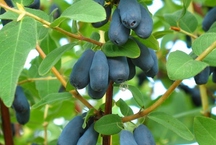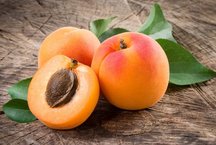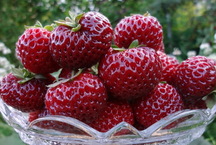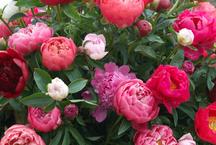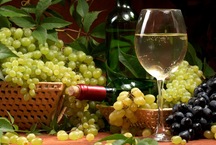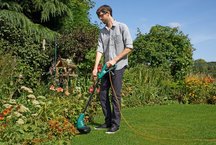Top 10 peach varieties

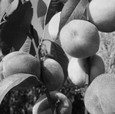
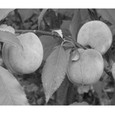


Peach is the most thermophilic representative of stone fruit crops. In the Middle Belt, where apricot does not submit to everyone, enthusiastic gardeners have found an approach to the tender peach. Back in 2006 - 2008, those who are trying to grow peach in the Moscow region in the open ground, they considered cranks. And today they are already discussing varieties that can bear fruit without shelter. We present you the description and photos of the best varieties of peaches - according to experienced gardeners.
In the southern regions, late peach varieties with more sweet and tender fruits are appreciated. But in the middle zone they choose the early ones, who will have time to mature and prepare for winter. Here, peach is an amateur culture with no prospects for industrial cultivation. In general, a positive attitude even skeptical gardeners, amateur peach in the Central region and the Volga region, a promising future. However, you should not count on the long life of the fruit tree - disease and freezing will lead to premature aging. The average lifespan is 5 - 8 years, but the peach is characterized by its precocity and yields a crop of 3 - 4 years.
Rating best peach varieties
| Category | A place | Name | Rating | Price |
|---|---|---|---|---|
| The best early peach varieties | 1 | Harrow diamond | 9.8 / 10 | 600 |
| 2 | Kiev early | 9.8 / 10 | 350 | |
| 3 | Novoselkovsky | 9.8 / 10 | 550 | |
| 4 | Saratov early | 9.7 / 10 | 500 | |
| The best mid-season peach varieties | 1 | Greensboro | 9.9 / 10 | 450 |
| 2 | Khasansky | 9.8 / 10 | 600 | |
| 3 | Redhaven | 9.8 / 10 | 600 | |
| 4 | Donetsk white | 9.8 / 10 | 550 | |
| 5 | Veteran | 9.7 / 10 | 350 | |
| 6 | Dnieper | 9.7 / 10 | 600 |
The best early peach varieties
|
Harrow diamond
600 (sapling in container)
Adapted Canadian peach variety of early ripening. Fruits ripen by the end of July. Tree vigorous. Fruits are oval, narrowed to the top, weighing 130-170 g, light yellow with a uniform dense flush on most of the fruit, slightly pubescent. The flesh is bright yellow, fibrous, juicy, sweet with a slight acidity. Stone separates badly. When overripe fruits are not showered. Gardeners from Moscow and Leningrad regions share in their positive experience in growing this peach. They note high marketability of fruits and abundant fruiting in the presence of winter shelter.
Main advantages:
Minuses:
|
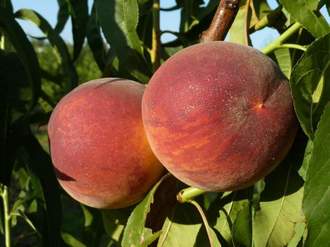 9.8 / 10
Rating
Reviews
This peach is definitely worth a look. One of the most recommended varieties. Although in recent times more winter-hardy forms appear. |
|
Kiev early
350 (one year with an open root system)
Our rating of the best peach varieties is continued by the well-known middle-early variety of Ukrainian selection. In the middle zone matures in late July. The tree grows quickly, reaches a height of 3-4 m, forms a dense spherical crown. With the help of trimming easily turns into a bush form, grow back flexible whips. Fruits are round, leveled, with pronounced abdominal suture and characteristic “beak”, medium hair, weighing from 60 to 100 g (at rationing of the crop), creamy with a bright yellow-red diffuse blush and visible stripes across the surface. The flesh is white, dense, sweet and sour, very aromatic. Stone is not separated. Shows sufficient winter hardiness for growing in the Moscow region. After harsh winters quickly recovers.
Main advantages:
Minuses:
|
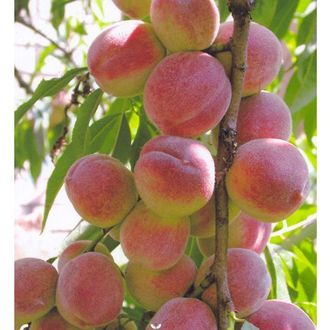 9.8 / 10
Rating
Reviews
Under winter shelter fruits annually. The fruits have a pleasant taste, but under high load they become very shallow. |
|
Novoselkovsky
550 (two years old)
Sredneranny Ukrainian peach variety.In the Central region ripens in the last decade of July - early August. The tree is low-growth, with a spherical compact crown. Fruits weighing 50 - 70 g, rounded, with pronounced abdominal suture, creamy with a pale blush. The peel has a moderate degree of pubescence. Pulp with a greenish tinge, tender, sweet and sour. Stone is average, fused with pulp. In the middle zone, this peach shows frost resistance at the level of minus 25 - 28 degrees. For the preservation of flower buds use shelter. It is successfully grown in the Moscow region and St. Petersburg.
Main advantages:
Minuses:
|
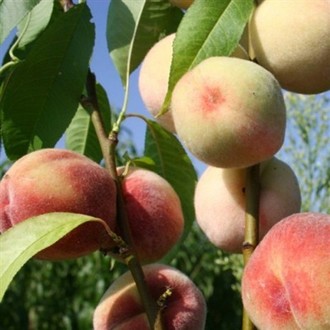 9.8 / 10
Rating
Reviews
A rather winter-hardy peach variety: winters winters under no cover. The fruits are very edible. |
|
Saratov early
500 (2-year-old seedling with root system in a package with peat)
Varformat from local varieties of a private breeder. The tree is stunted. Ripens in mid-early dates: the beginning - the middle of August. Under the snow cover winters without shelter, but to guarantee yields in the Volga region it is recommended to shelter. The compact size of the crown facilitates the work. The fruits are round, slightly flattened, with a pronounced abdominal suture, pale yellow with a slight red tan, weighing 70 - 100 g; pubescence is insignificant. The flesh is creamy, aromatic, dense and juicy, sweet and sour. The small bone is easily separated from the pulp. This peach variety is characterized by high frost resistance and resistance to temperature extremes in winter. The variety is grown by amateur gardeners from Saratov, Nizhny Novgorod, Voronezh, Moscow and Samara.
Main advantages:
Minuses:
|
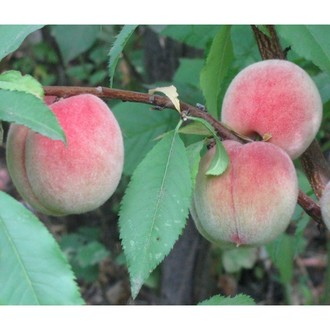 9.7 / 10
Rating
Reviews
Quickly adapts to new growing conditions, interesting for the promotion of peach in more northern regions. |
The best mid-season peach varieties
|
Greensboro
450 (sapling with open root system)
Old American mid-season peach variety. The tree is tall with a wide spreading crown. In the middle zone ripens in the second decade of August. Fruits are roundish, greenish-cream with an extensive dot bright blush, slightly oval, with a notch on the top, weighing 110 g; abdominal suture shallow; pubescence of the skin is strong. The flesh is creamy, juicy, fibrous, aromatic, sweet-sour harmonious taste. Stone fused with pulp. In the Moscow region demonstrates good winter hardiness with covering culture and excellent taste. Fruiting begins at 2 - 3 years after planting.
Main advantages:
Minuses:
|
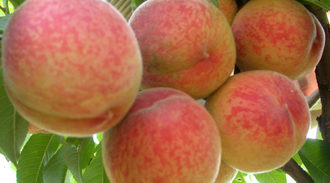 9.9 / 10
Rating
Reviews
Under the conditions of the Moscow region, the greensboro peach gives regular yields when forming a bush with shelter for the winter. Diseases require preventive treatment. |
|
Khasansky
600 (one-year sapling in a container)
Winter-hardy mid-season variety of national selection from Novosibirsk. Ripens from mid-August. The tree is short with active shoot formation. Fruits without shelter and rationing have a mass of 35 g, but with more attention they can reach 100 g. They are oval, light cream, with a slightly blurry pink blush, with weak pubescence. The flesh is white with reddish inclusions near the bone, tender, juicy, sweet-sour, with a faint odor. Stone separates easily. Used more often for recycling. In the inoculation the fruit is already next year, the planted sapling pleases with a crop for 2 - 3 years. In the Primorsky Krai winters safely and bears fruit without shelter.In the suburbs in harsh winters freezes, but quickly grows over the season. Responds well to rejuvenation.
Main advantages:
Minuses:
|
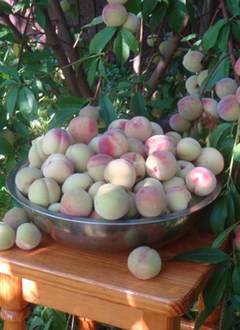 9.8 / 10
Rating
Reviews
In the Bryansk region gives small, but numerous fruits of decent taste. |
|
Redhaven
600 (2-year-old sapling with ZKS)
Next in our ranking is the North American mid-season peach variety for industrial gardens. The tree shows an average growth force, which is limited by grafting on almonds. Forms sprawling crown. Fruits are oval, slightly flattened, weighing up to 150 - 200 g, yellow with a reddening blush on most of the fruit, slightly pubescent. The flesh is orange with reddish veins near the bone, juicy, fibrous, sugar dominates in taste. When ripe, the stone is freely separated from the pulp. For winter hardiness, this peach variety is at the level of standards and requires shelter.
Main advantages:
Minuses:
|
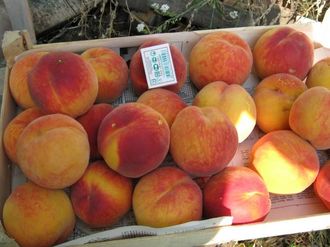 9.8 / 10
Rating
Reviews
In my large collection gives the most delicious fruits, very close to the southern ones in taste and size. |
|
Donetsk white
550 (2-year-old sapling, ZKS)
Good mid-season peach variety of Ukrainian selection. The tree is vigorous, with a spherical dense crown. Fruits are round-oval, slightly flattened, with a small abdominal suture, with weak pubescence, snow-white, acquire a red blush in the sun, weighing from 70 to 140 g (when normalized). The flesh is white, tender, very juicy, the taste is dominated by sourness. Stone is not separated from the pulp. The variety is characterized by extended ripening. Easily tolerates repeated rejuvenation. Recommended for areas not typical for the cultivation of peaches: widespread in the Volgograd region, grown with a shelter in the suburbs.
Main advantages:
Minuses:
|
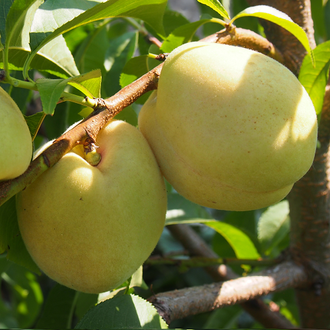 9.8 / 10
Rating
Reviews
With proper care and compliance with agricultural crops, the harvest of peaches is guaranteed. The variety is reliable and durable. |
|
Veteran
350 (one-year sapling with open root system)
A common Canadian peach variety adapted to the Russian climate. Tree srednerosloy, 3 - 4 m high, with spherical dense krone. Maturation occurs in the first decade of August. Fruits are round, sometimes flattened, with a depression at the top, weighing 155 g, yellow with an extensive orange-red blush, and the abdominal suture is clearly visible. The skin is dense, with velvety pubescence. The flesh is yellowish, fragrant, juicy, sour-sweet, when fully ripe, the sourness is slightly palpable. Separation of the bone is difficult. It has a high degree of self-fertility and increased precociation (fruiting for 2 - 3 years). Winter hardiness is above average. This peach variety is grown in the Moscow region and Voronezh region.
Main advantages:
Minuses:
|
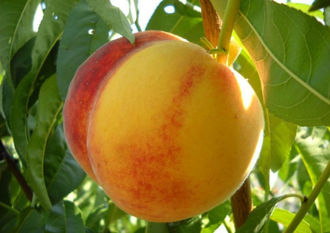 9.7 / 10
Rating
Reviews
Abundant fruiting gives only with shelter, otherwise you can count on individual fruits. Relatively well tolerated return frost. |
|
Dnieper
600 (2 year old sapling)
Ukrainian mid-season peach variety. Under the conditions of the Middle Band it ripens in 2-3 decade of August A tall tree with a spreading and branched crown. Fruits are round-oval, weighing 100-150 g (some up to 200 g), yellow with a broad diffuse blush, with a gentle pubescence; on top there is a noticeable dimple, from which there is a pronounced abdominal seam of medium depth.The flesh is milky-white with a yellowish tinge, juicy and sweet with a pleasant sourness, fragrant, with a well-separated bone. Gives abundant flowering and regular fruiting, has a high degree of self-fertility. It grows well and bears fruit in the Primorsky Territory and the Moscow Region.
Main advantages:
Minuses:
|
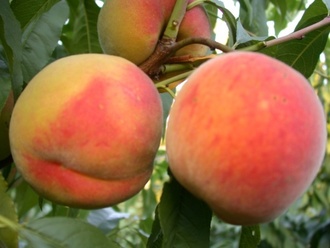 9.7 / 10
Rating
Reviews
The fruits are quite sweet and juicy, but the taste in rainy summer is simple, without raisin. The tree overwinters well, but the flower buds are partially damaged in severe winters. |
The main enemies of peach in the Middle Zone are: frosty winters, curliness, gumming and subduing. It is easier for the apricot to bear the spring frosts, but due to the short period of rest it is strongly affected in the second half of winter, waking up after the first thaws. In the little snowy winters, not only flower buds but also wood freeze out. Therefore, the cultivation technology includes:
- landing in sheltered from the south side;
- formuli in stanrantsev form or bush;
- shelter dense breathing material (lutrasil, spunbond) in tunnels, "columns" or with bending down arcs;
- hilling with snow;
- complex preventive treatments;
- seedlings on a stock that is resistant to podprevane - hybrid plum and Manchurian peach.
Experienced gardeners successfully grow seedlings from conditionally winter-hardy varieties that are more adapted to a specific climate. Search for the desired varieties of peaches better in local nurseries, where seedlings underwent primary acclimatization and survived at least one winter. Do not neglect the little-known varieties and seedlings from local private breeders.
If you can not find a sapling of the selected variety - you can purchase and sow seeds. In this case, it will take more time to get a fruiting tree, but the probability of preserving the grade of peaches during seed reproduction is very high. In addition, seedlings are more viable.
Have a good harvest!
